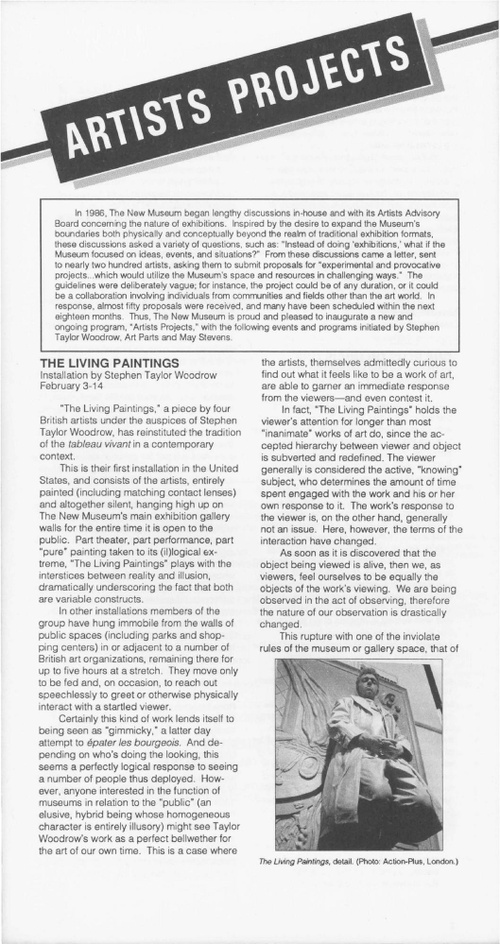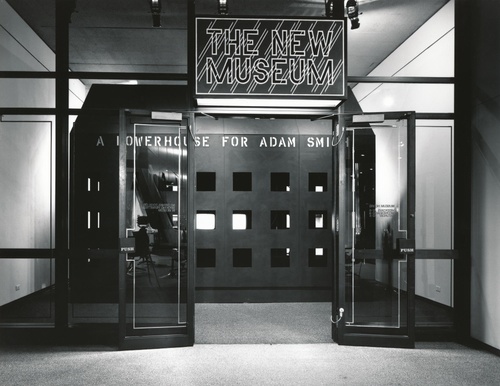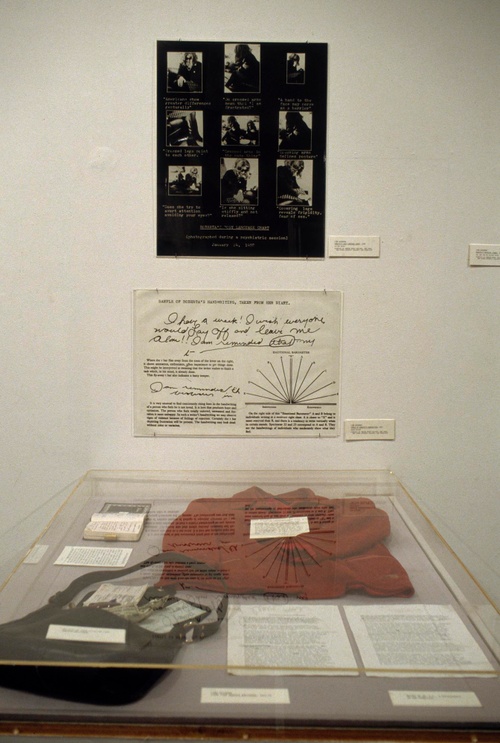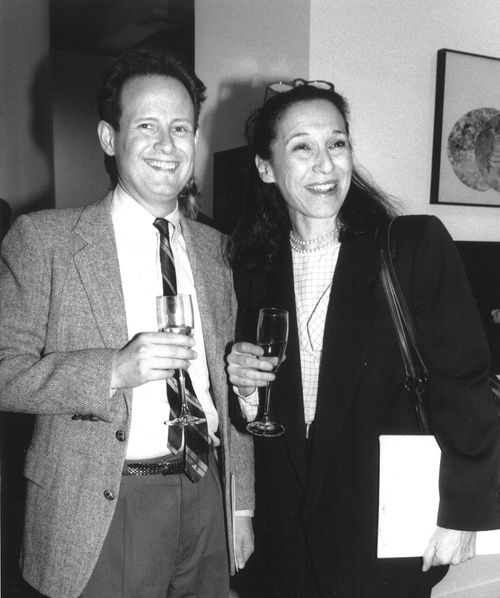Oral History: Lynn Gumpert
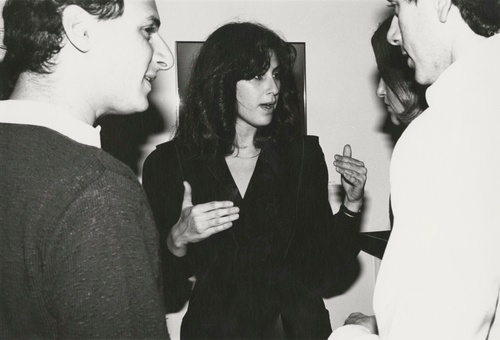
Lynn Gumpert speaking to Norman Kleeblatt (left) and other guests at the opening of “Persona,” 1981. Photo: Lisa Kahane
NEW MUSEUM ORAL HISTORY INITIATIVE
LYNN GUMPERT, CURATOR & SENIOR CURATOR, 1980–88
INTERVIEWEE: Lynn Gumpert, Director, Grey Art Gallery, New York University
INTERVIEWER: Johanna Burton, Keith Haring Director and Curator of Education and Public Engagement, New Museum
LOCATION: Offices of the Grey Art Gallery, New York University, on June 9, 2017
This interview has been condensed and lightly edited from the verbatim transcript. Readers are asked to bear in mind that they are reading a transcript of the spoken word, rather than written prose.
Full transcripts are available from the New Museum Archives by request.
Johanna Burton: I’d like to focus on your time at the New Museum, but I think you’re also a great example of somebody who can reflect on the time both before and after you were at the New Museum, and who can think about kinds of institutional priorities with a little bit of distance as well.
What brought you to the New Museum, in 1980?
Lynn Gumpert: Sure. So, I grew up in Marin County in Northern California. First generation, of parents who had fled Nazi Germany. They settled in San Francisco. I went to Berkeley as an undergrad, discovered art history, realized that was what I wanted to do. I spent my junior year in Paris at the École du Louvre. I then went to graduate school from 1975 to ’78—at the University of Michigan, did all my doctoral coursework, and then I got frustrated with academia and moved to New York.
My first job in New York, was working for a very few months at Blum Helman Gallery, and then a position opened up at the Jewish Museum, and I worked there as a curatorial assistant with Susan Goodman for two years. When the job for a curator at the New Museum was posted in the New York Times, I applied for it.
Johanna Burton: Do you remember the interview?
Lynn Gumpert: I remember one interview in particular. I think it was the second interview with Marcia Tucker [founding Director, 1977–98] at the Elephant & Castle restaurant on Greenwich Street. That’s what I remember the most.
Johanna Burton: Do you recall what drew you to the New Museum, or what was interesting about it at that time?
Lynn Gumpert: I know that when I first arrived in New York in ’77, I spoke with a woman named Diane Harris, who, I think, at the time was working for Pace Gallery. And she mentioned to me, “Oh, you know, Marcia Tucker has just started this museum, but she’s only working with volunteers.” Diane had mentioned it was exciting but I needed a paying job!
I was happy to move to New York, where I’d always wanted to be. I became more involved with contemporary art. My early studies had been more modernist, and turn of the twentieth century.
I was excited about the opportunity to work in a small museum. I think I’ve always been interested in institutional practice. The first paper I gave at CAA [College Art Association], in 1980, addressed what it means when you commission a work of art for an artist as an installation. Who owns it? What kind of contracts do you do? What are the ownership issues around that? What happens if an artist sells the work later on? Are the costs and materials reimbursed? Those kinds of issues.
I think I was drawn to the fact that the New Museum was very experimental, and flexible. And I liked that. I was very fortunate to have worked for two years at the Jewish Museum, where I learned the basics of how museums operate. And I was lucky, also, that it, too, was a small museum, so you got access to everything.
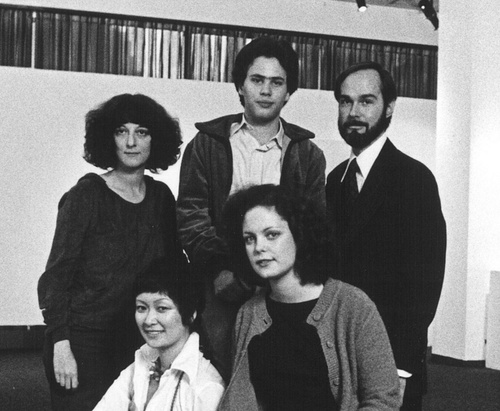
Early New Museum staff, ca. 1978. Clockwise from upper-left: Marcia Tucker, Allan Schwartzman, A.C. Bryson, Susan Logan, Michiko Miyamoto. Photo: Warren Silverman
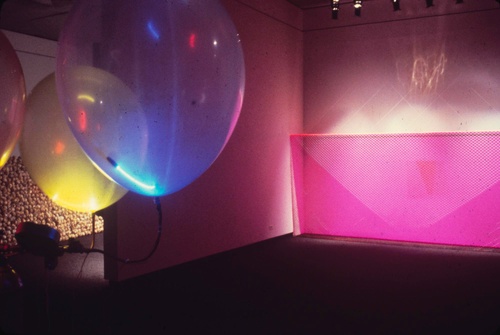
Exhibition view: “Dimensions Variable,” New Museum, 1979. Mounted the year before Gumpert joined the Museum as curator, the exhibition presented elusive, changeable, and materially unstable works designed to produce ephemeral perceptions and experiences.
Johanna Burton: So, when you moved to the New Museum in 1980—can you describe it? The Museum was still housed within the New School?
Lynn Gumpert: It was definitely housed within the New School. The office was very small. Everybody shared an open space, except for the Development Director and Marcia, who both had small enclosed offices.
When I got there, Allan Schwartzman [Curator, 1977–80] was working. I think the other early curator, Kathleen Thomas [Curatorial Associate, 1978–80], had already left.1 We might have overlapped a little bit. Cheryl Cipriani [Curatorial Coordinator, 1977–81] was still there, as well as Ed Jones, who was the Head of Education [1980–84].2
Johanna Burton: Right. The education programs have been really, again, key, I think, in terms of not thinking about education as supplementary, but as central.
Lynn Gumpert: Exactly.
Johanna Burton: What was the vibe like in the office?
Lynn Gumpert: I don’t know how to describe the vibe. I remember very specifically having staff meetings where we would all sit in the exhibition space, because there wasn’t enough room in the offices, before the museum would open. The gallery was off the lobby, and it had these carpeted floors. It was kind of a funky space. We’d sit around in a circle at the staff meetings. And, of course, Marcia promoted this nonhierarchical notion that everybody would all have equal say and we’d all have a chance to take part.

Lynn Gumpert and Ned Rifkin at the New Museum offices in the New School, 1982. Photo: Rosemary Ricchio
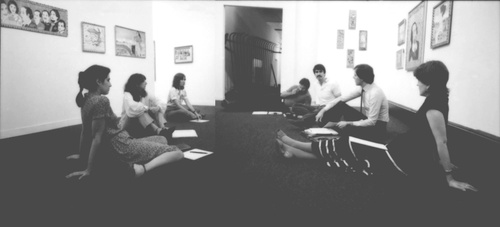
The New Museum staff attends a meeting in 1982. Pictured, from left to right: Lynn Gumpert, Marcia Tucker, Maureen Stewart, John Jacobs, Ned Rifkin, Ed Jones, and Robin Dodd. Photo: Rosemary Ricchio
Johanna Burton: [Laughs.] You know, the folklore is—because I think people aspire now to some of these models, or have a nostalgia for them—that everyone was also paid the same. Do you remember if that was true?
Lynn Gumpert: Yeah. There was a lot of discussion about that. And I don’t remember if it actually was the case. Allan Schwartzman might know. But, in any case, that didn’t last that long.
Johanna Burton: It’s an interesting proposition.
Lynn Gumpert: It is a very interesting proposition. And that was the best thing that Marcia was about, again, kind of throwing out these curveballs and getting you to think outside the box and think, Why do we do things in a certain way? Can there be another way?
Before you arrived, I was looking over the exhibition catalogue for “Temporarily Possessed: The Semi-Permanent Collection” [1995] and what Allan said. He noted that Marcia herself had kind of talked about a benevolent dictatorship.3 She talked a lot about wanting everything to be nonhierarchical and by consensus. Consensus was the big word.
Johanna Burton: Right.
Lynn Gumpert: But she wanted it to be her consensus. [Laughs.]
Johanna Burton: Right.
Lynn Gumpert: And I think that everybody realized and everybody acknowledged that she should be the deciding voice. That she was the Director. The Museum was her vision.
But I think everybody also really enjoyed the opportunity to be able to give their opinion and raise ideas. That was the best part about it.

Marcia Tucker (right) with Ned Rifkin (left) and John Jacobs (center) at the New Museum office, ca. 1981. Photo: New Museum
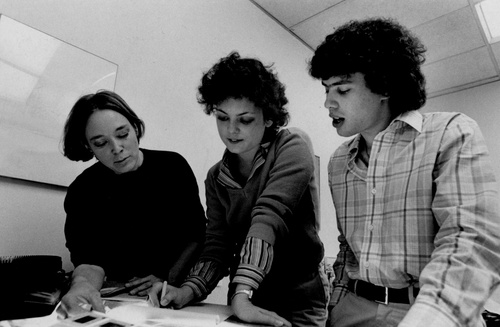
Pictured, from left to right: Kathleen Thomas, Susan Logan, and Allan Schwartzman, review slides in the New Museum office, 1978. From its earliest days New Museum staff reviewed slides submitted by artists. Photo: New Museum
Johanna Burton: When you first started at the Museum, what were your priorities for choosing artists that you wanted to show?
Lynn Gumpert: Well, the thing that I remember the most – and this is what I’ve talked about the most when I’ve talked about my days at the New Museum – was Marcia’s philosophy that you looked at as much art as you could see and then curated things that stuck with you, or that you were bothered by, or that you responded to—the things that made you think the most.
That it was not to say, “This artist is going to be the important artist who is going to survive this period,” but “Out of all the works that I’ve seen”—I’m always in a sense qualifying it—“what I see in this artist is the most interesting to me because either it’s more provocative, or the work is bringing up new issues, or the artist is tackling different kinds of subject matter.” So, we just chose the work that resonated the most with us.
Johanna Burton: Right. So, in a way, working against the idea of posterity—
Lynn Gumpert: Yes. Exactly. That’s exactly right. So that it was just that this work makes sense within this context.
Johanna Burton: Now.
Lynn Gumpert: Now. And out of all the work I’ve seen, I feel it should be presented in the public context. Because, I think, we were working on the show “Persona” [1981], so we looked at a lot of different work.
I think Allan was finishing up a show of artists from Ohio [“Outside of New York: The State of Ohio,” 1981], and I think at that point he was getting pretty tired from traveling to curate shows of work from other places. He had started as an intern. I was the first curator that had an advanced degree — a master’s degree.
Johanna Burton: Oh, I see. It’s also interesting because you were one of the first curators to want to look outside of New York.
Lynn Gumpert: Well, Marcia had always looked outside of New York within the US.
Johanna Burton: —Within the US.
Lynn Gumpert: But I was the first to look outside the US.
Johanna Burton: Yeah. But also in the US, you all prioritized local context in a way—
Lynn Gumpert: Yeah, there was always a show every year called “Outside New York.”4
Johanna Burton: Right. This is what I mean—going to the local contexts outside of New York, to more regional areas. It’s an impulse we’ve been thinking about with the recent political context being what it is—which is, how does one sort of consider the United States not as a cohesive geography?
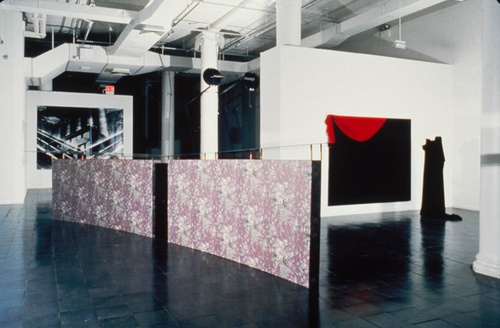
“A Distanced View: One Aspect of Recent Art from Belgium, France, Germany, and Holland,” introduced the works of fourteen artists chosen for their hybrid approach to media, and the decorative and fine arts. Exhibition view: New Museum, 1986. Photo: New Museum

“Outside New York: The State of Ohio” (1980) aimed to present the diversity of work being created across the state’s major centers, including Akron, Cincinnati, Cleveland, Columbus, and Dayton. Exhibition view: New Museum. Photo: New Museum
Can you speak a little bit about your own perspective on that moment—I’m thinking also about the founding of the Museum, but certainly the early part of the ’80s into the mid-’80s—where ideas of overt politics were really being thought of in terms of the Museum? I’m curious to hear you talk a little bit about that period.
Lynn Gumpert: Yes. I curated a show called “The End of the World” from 1983 to 1984. And I think that was very much around the time that Ned and I worked on the retrospective of Leon Golub [1984]. Leon and Nancy Spero were nearby and such prominent presences in the New York art world at that time. And I think Ned shared that interest in presenting work that dealt with social and political critique.
So, I think the idea of overt politics in opposition to mainstream culture was definitely in the air. People were aware of it. We had done “Alternatives in Retrospect” [1981], and that kind of led up to it.
But then, also, the Events: “Fashion Moda” exhibition in 1981. That’s when Keith Haring came and did his first wall piece in a museum [Christmas Story (3 parts), 1980].
And we always talked a lot about politics and diversity. Marcia was very, very concerned with this notion early on, far ahead of most people, which was pretty remarkable. And we just wanted to have a forum where more and different kinds of people could exhibit their work, so we were always open to looking at that issue. Everybody on the staff bought into that idea and felt that it made sense.

Leon Golub, Vietnam III, 1974. Installation view (detail): “Golub,” New Museum, 1984. Photo: New Museum

Nancy Spero and Leon Golub both directly addressed issues of violence in contemporary culture through their respective practices, responding to subjects such as the Vietnam War, Central American conflicts, and violence against women. Pictured: Curator Brian Wallis moderates an ArtQuest panel discussion hosted by Leon Golub (center-right) and Nancy Spero at their studio in 1986. Photo: New Museum

Events: “Fashion Moda” was part of a series of exhibitions presented from 1980 to 1981. Events challenged the traditional function of the museum to choose, select, and edit by inviting artists’ groups to curate exhibitions in the New Museum. Fashion Moda was an art space located in the South Bronx that was created with the intention of presenting art and ideas from cross-cultural sources in order to reach audiences with the widest possible spectrum of educational, economic, and cultural backgrounds. Photo: New Museum
Johanna Burton: Do you remember what kind of community sort of showed up for all the public events at the time?
Lynn Gumpert: A very diverse community. When I co-curated “Persona” in 1981, apparently, the performance artist Lorraine O’Grady turned up at the opening and did an impromptu performance.5
Johanna Burton: Yes, a guerilla performance.
Lynn Gumpert: Yes, which was fantastic.
Johanna Burton: Yeah.
Lynn Gumpert: And I think I was happy that she came, and then a bit chagrined that I hadn’t come across her work beforehand. Another person who had also been very influential at the time was Linda Goode Bryant, who ran Just Above Midtown [a nonprofit artist space in New York from 1974 to 1986, dedicated to artists of color].
Johanna Burton: Oh, right. Of course. Who showed O’Grady’s work.
Lynn Gumpert: Yes, and who showed a number of African American artists.
Johanna Burton: You’ll be happy to know Lorraine came during a Simone Leigh project a year ago [“Simone Leigh: The Waiting Room,” 2016] and performed a public event called Ask Me Anything About Aging [2016], where she took questions from the audience. And we tried to claim her as having shown at the New Museum, but it was really interesting to actually talk about what that history really was.
Lynn Gumpert: Yeah. And she was very, I mean, she was completely right that “Persona” should’ve included work by artists of color.
Johanna Burton: She was totally correct, yes –
Lynn Gumpert: – that it has to do with access. Again, with who you know and what you’re exposed to. It was harder. You had to dig deeper.
Johanna Burton: And it seems as though, as you point out, a lot of these questions that Marcia was bringing up were around diversity and access. For instance, she directly addressed class in a way that is actually still not completely resolved. Or really even on the table.
Lynn Gumpert: Or talked about that much.
Johanna Burton: So, I think part of why I’m curious about your all going to other states as well was that a lot of the talks that Marcia gave in different communities directly addressed the patron system and how class, and race, and gender are so entwined. It’s interesting to read those documents.

Linda Goode Bryant and Ana Mendieta at the panel ‘Art and Politics II: Integrity and Esthetics’ at the New Museum, 1982. The discussion was part of a series that addressed the relationship of fine art to the social, political, and cultural climate in which it is produced. Photo: Lisa Kahane
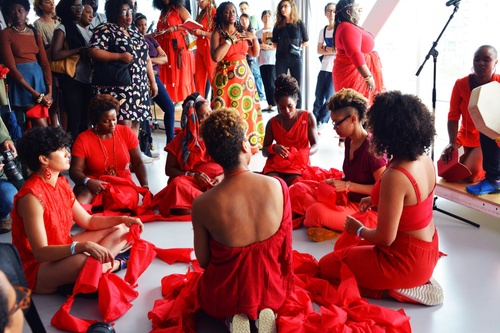
‘Black Women Artists for Black Lives Matter’ public program that took place during “Simone Leigh: The Waiting Room,” New Museum, 2016. Photo: New Museum
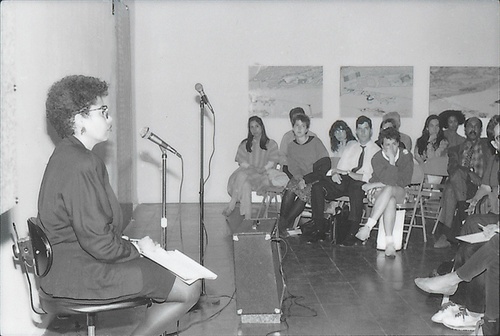
Kinshasha Holman Conwill, Director of the Studio Museum in Harlem, moderating “Open Forum” (1988), a panel organized in conjunction with “The Decade Show: Frameworks of Identity in the 1980s,” a major exhibition examining the art of the 1980s, co-curated by the New Museum, the Studio Museum in Harlem, and the Museum of Contemporary Hispanic Art. The event provided a forum for community members to discuss issues and concerns relating to the exhibition during the planning phase. Photo: Annette Schwed
So, tell me about that transitional stage with the move to the Broadway location.
Lynn Gumpert: A big moment for the Museum was during the Venice Biennale [“Paradise Lost/Paradise Regained: American Visions of the New Decade,” 1984].
Johanna Burton: I want to talk about that too.
Lynn Gumpert: Yeah. It was in 1984.
Johanna Burton: Uh-huh, so mid-term for you?
Lynn Gumpert: Yeah. I didn’t get that involved with the Venice Biennale. Marcia and Ned went, which was fine because I was working intensely on “The End of the World: Contemporary Visions of the Apocalypse” [1984] at that time. So, all of those themes coincided.6 [](footnote “print-ephemera/6445”)
And, it was interesting times. We organized some really wonderful shows of Ana Mendieta’s work [“Ana Mendieta: A Retrospective,” 1987–88, and “The Decade Show: Frameworks of Identity in the 1980s,” 1990]. We had some really interesting guest curators.
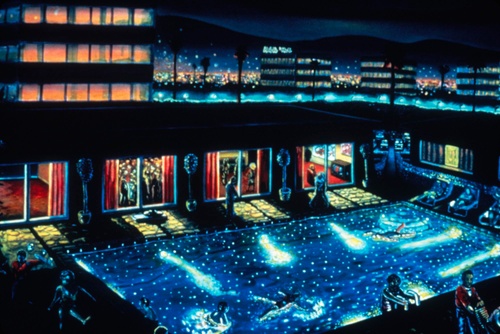
Night Pool, 1980
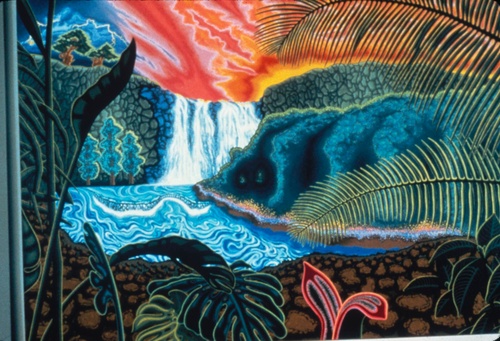
Robert Yarber’s 1980 work Night Pool (top) and George T. Green’s 1980 work Fragment of Paradise (bottom) were included in “Paradise Lost/Paradise Regained: American Visions of the New Decade,” exhibited at the Venice Biennale in 1984. The exhibition presented American painters who were actively reassessing the American Dream through the legacy of nineteenth-century landscape traditions. Photos: New Museum
And then, also, it was very interesting after Ned left and Bill Olander started in 1985. Bill was great.
Johanna Burton: Yeah.
Lynn Gumpert: He was really fantastic. And that was very difficult when he became ill.7 It was, of course, devastating for everybody.
Johanna Burton: Yeah. He has, for me, been a really important precedent. And I’ve been going back to a lot of his work. He died so young [at thirty-eight years old].
Lynn Gumpert: He died very, very young. And I had met him earlier at Oberlin College.8 He had me come out to Oberlin to jury a show for the Ohio Arts Council in 1983. And his early Oberlin exhibitions were all fabulous. So, having him there at the New Museum was great.
Johanna Burton: Did you work directly together on any projects?
Lynn Gumpert: No. By that point, the curatorial staff were no longer collaborating on shows.
Johanna Burton: You were doing separate shows.
Lynn Gumpert: We were. Ned and I collaborated on two or three shows. And then, by the time that Ned left, we were each working on our own shows.
Oh, and Russell Ferguson had started by that point, too. But he was also the librarian [1986–91].
Johanna Burton: Mm-hmm. Do you remember the critical anthologies starting up, which Russell had a hand in editing [Documentary Sources in Contemporary Art, 1984–2004]?
Lynn Gumpert: Yes, very clearly.
Johanna Burton: And what were the conversations around those?
Lynn Gumpert: The conversations were really lively. It was great. We all felt that this was a really important endeavor, to make real books. Hank Luce [President of the New Museum Board of Trustees, 1978–98] was a funny character, but he made a lot happen.9
Johanna Burton: To me those books remain a really important part of —
Lynn Gumpert: And they were absolutely essential and, you know, helped with theory—just being able to put together a bunch of different things. And Brian [Wallis]—he oversaw them with Phil Mariani, who was the designer, if I remember that correctly.
Johanna Burton: Yeah. It’s a really interesting part of the history.
Lynn Gumpert: Yeah, the history of the Museum. And I think, again, this was one of Marcia’s strengths, that she saw the big picture, and she realized that it wasn’t one thing or the other, but a combination of different kinds of activities. We were not going to be throwing the baby out with the bathwater, necessarily.
Johanna Burton: Yeah, absolutely.
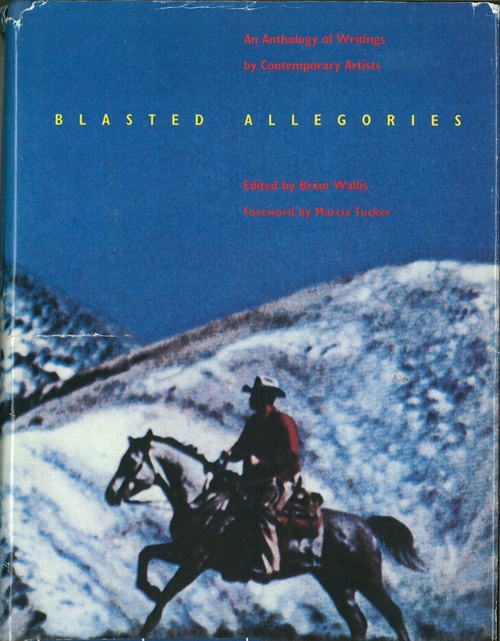
The second volume in the Documentary Sources in Contemporary Art series, Blasted Allegories: An Anthology of Writings by Contemporary Artists (1987), brings together writings by artists such as Kathy Acker, John Baldessari, Dan Graham, Edgar Heap of Birds, Matt Mullican, Lynne Tillman, and Carrie Mae Weems, among others. It addresses issues related to image, culture, and identity through shifting, multilayered techniques of allegory in texts that bridge the personal and political, from individual feeling to mass phenomena.
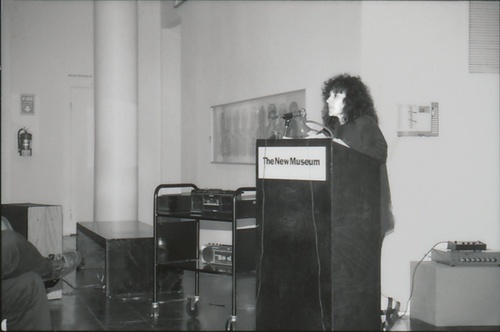
Lynne Tillman reading from Blasted Allegories: An Anthology of Writings by Contemporary Artists, New Museum, 1989.
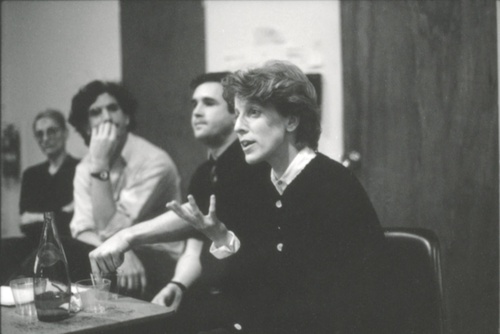
Pictured (left-right): Nancy Spero, Brian Wallis, Tim Rollins, and Phil Mariani. ArtQuest panel at Leon Golub and Nancy Spero’s studio, New York, 1986.
So, you’ve described your time at the museum as “intense, challenging, exhilarating, and frustrating, not always in that order.” What was the best about being at the Museum, and what was the hardest?
Lynn Gumpert: The best was this notion of collaboration, of true collaboration, of being open, of being able to have an idea and run with it. For example, I was saying to Marcia, “We should go to documenta.” And she said, “Sure. How do we do it?” And then being able to take that idea and not face bureaucracy or hurdles. But you could think creatively, then find a way to do it.
Johanna Burton: You worked with a tremendous number of artists while you were at the New Museum. I’ll name a few of them: Joan Jonas, Al Wong, Martin Puryear, Barbara Ess, Bruce Nauman, Ana Mendieta—I mean, there’s a huge list, actually. And you also worked on thematic and argument-driven shows.
Can you talk about those two things? Again, for you, what was, at that time period, interesting?
Lynn Gumpert: Sure. One of Marcia’s kind of rules again, or one of her philosophies—rules is the wrong word—but one of her underlying core philosophies was, “Don’t come up with a theme and try to find an artist to fit that theme. But try to find out what artists are talking about or what they’re thinking about, and that will suggest a theme.” And that can be a way in which you can put together an exhibition.
And again, it was always, “Well, this is one way of looking at things. It’s not the only way, but we can look at these artists from this vantage point at this time.”
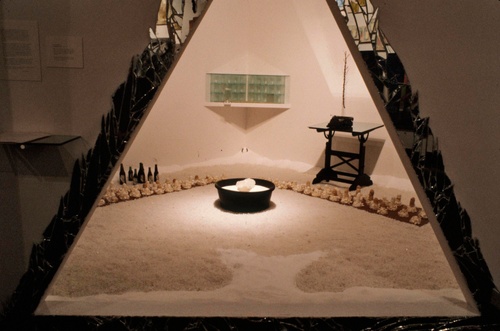
Jamie Summers, Metamorphic Rite, 1983
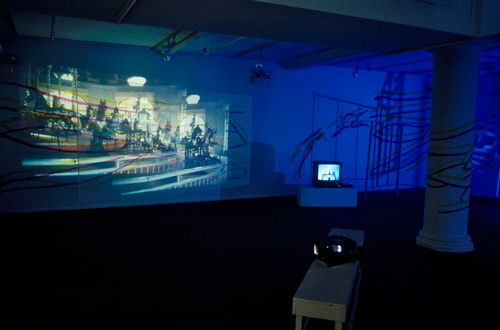
Envisioned as an intermediary between the artist’s studio and the museum gallery, the WorkSpace series allowed artists to develop each installation during a month-long residency. Pictured, above: Installation view: “Workspace: Eleanor Dube, E'wao Kagoshima, Jamie Summers,” New Museum, 1983. Below: Exhibition view: “WorkSpace: “Joan Jonas,” New Museum, 1984. Photos: New Museum
Johanna Burton: I want to just touch on a couple of things before we move to now. Can you talk a little bit about the slide project that you did with Marcia of unknown artists? I want to know more about that.
Lynn Gumpert: The slide program.
Johanna Burton: Yeah.
Lynn Gumpert: We were very open to having anybody submit slides that we would look at. I think we had a regular schedule where we would look at the slides and decide if we’d do studio visits. And so, at that point, especially in the first half of my tenure there up until the mid-’80s, there was probably nobody who showed in SoHo or Tribeca whose slides we hadn’t seen. We always had an intern or a volunteer help us then send a letter back and say, “Please submit new slides in a year.” We tried to keep on top of it. We had just five-by-six index cards, and we’d write every time who wrote in or who looked at them. So, we kept this pretty big card file of all the artists who had submitted slides.
I remember that Peter Halley submitted his slides, and they stood out because they were geometrical—nobody else was doing geometrical painting at that point—and I went to do a studio visit. So, it was well-used. I mean, I think people always appreciated it. It was a little bit like the Drawing Center’s open policy of reviewing artists.
So that was a really key part, and I don’t know if we reviewed them once a week, or every other week, but the card system was very helpful in keeping track. And then we also had slide showings where we’d just sometimes pick images that had come through the slide viewing program and show them. I think there are lists of those, too. It’s almost a community service, just saying there are people here that will look. In a sense, giving back to the community.

Pictured, from left to right: Susan Logan, Allan Schwartzman, and Kathleen Thomas review slides in the New Museum office, 1978. From its earliest days New Museum staff reviewed slides submitted by artists. Photo: New Museum
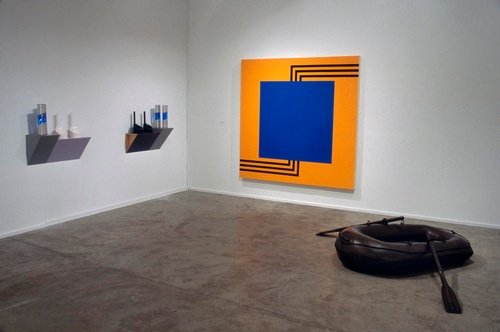
Halley’s paintings were presented in two New Museum exhibitions, including “East Village USA,” a survey of the sprawling art scene that emerged adjacent to the New Museum during its early years. Peter Halley, Glowing Cell and Burnout with Conduit, 1982. Installation view: “East Village USA,” New Museum, 2004. Photo: Jason Mandella
Johanna Burton: I believe Lisa Phillips [Toby Devan Lewis Director, 1999–present] told me that you would call for proposals, and that artists could come up with ideas for exhibitions also.
Lynn Gumpert: Oh, there was a moment where we just had this open proposal system. This was a series of projects where artists could take over the entire Museum.10
Johanna Burton: Ah, okay.
Lynn Gumpert: I remember we got one proposal to keep the Museum open for forty-eight hours, or three or four nights all the time—it was Chris Burden.
Johanna Burton: Yeah.
Lynn Gumpert: With a ton of light bulbs.
Johanna Burton: I sometimes use the archives for exhibitions in our Resource Center. And, in fact, we had the proposal from Chris Burden on display when his show was up in an accompanying exhibition called “Pushing the Limits” [2013]. It was the Fist of Light proposal [1986]. It was never, of course, realized by the New Museum.
Lynn Gumpert: No.
Johanna Burton: But it’s interesting to see those things. And we, from time to time, pull those things out of the archive and show them.
Lynn Gumpert: Yeah, I think, again, it was part of Marcia’s desire, and our desire as well, to try to rethink what a museum could be. The idea of the New Museum.
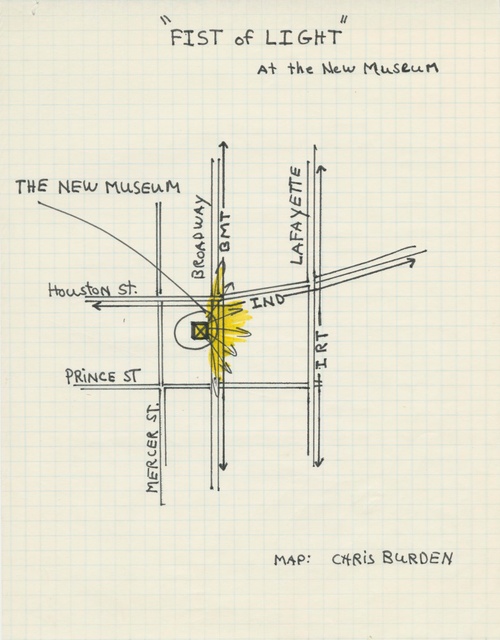
Chris Burden’s proposal for Fist of Light, which he submitted to the New Museum in 1986. The proposal was turned down by the New Museum and was eventually realized by the Whitney Museum of American Art in 1993. This proposal was included in “Pushing the Limits” (2013), an exhibition at the New Museum that included materials from the Museum’s archive that illustrated artists’ strategies for testing the parameters and limits of the institution.
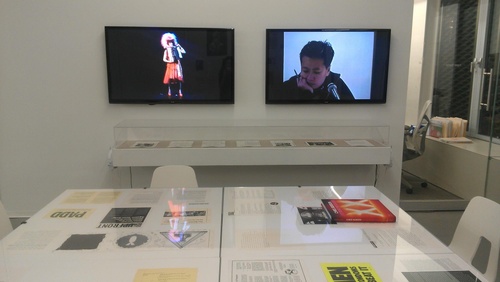
Exhibition view: “Pushing the Limits,” New Museum, New York, 2013.
Johanna Burton: So, is there anything that I haven’t touched on that you would like to talk about?
Lynn Gumpert: You know, the part of the history that I remember, too, is just taking groups around to artists’ studios. And Vera List [New Museum Trustee, and Trustee Emeritus, 1977–2002]—she would buy something, then everybody else would buy something. And Elaine Dannheisser [New Museum Trustee, 1979–89], and all these amazing collectors that, kind of, came on board. Those were memorable.
I remember one of the first things for me when I first came to the Museum was taking Joan Mondale and a group of supporters to artists’ studios. In particular, I remember one visit circa 1980 where there was a rat on one of the steps of one of the lofts as we were walking up. [Laughs.]
So, I remember the dynamic that our Trustees and collectors brought as being a very important part. It was a very interesting group of people.
Then, also, Marcia’s belief, you know, that we shouldn’t ask artists for artwork at galas, because that’s their livelihood. But you could ask them to make a hat, or you could ask them to make a mask. And so, that’s how a lot of the first galas were. I still have a hat by Mary Stoppert that I bought at an auction.
Johanna Burton: Wow.
Lynn Gumpert: Well, I think that’s good.
Johanna Burton: Thank you.
[End of interview.]
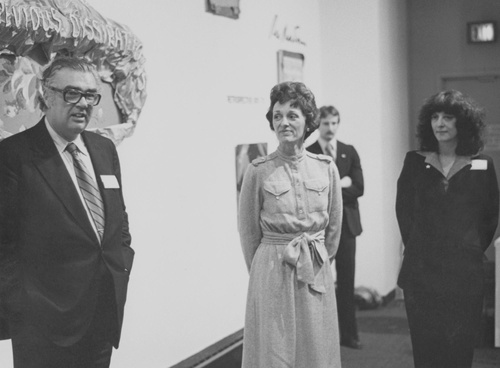
Left to right: Henry “Hank” Luce III, Joan Mondale, and Marcia Tucker visiting the New Museum’s exhibition “Ree Morton: Retrospective 1971–1977” during an artist’s studio tour in 1980. Photo: New Museum
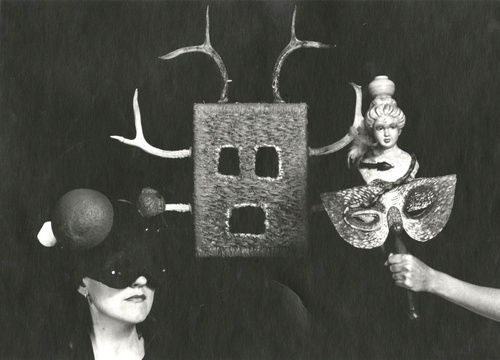
Left to right: Masks for Celebration III silent auction, featuring works by James Holl, James Hill, and Phyllis Bramson, 1981. Photo: Lisa Kahane
-
An early New Museum newsletter notes, “Lynn began work in March, 1980, following Kathleen Thomas’ decision to leave the Museum.” New Museum News, Winter 1979/Spring 1980, 19.
, 1980The New Museum News – (Winter 1979 / Spring 1980)
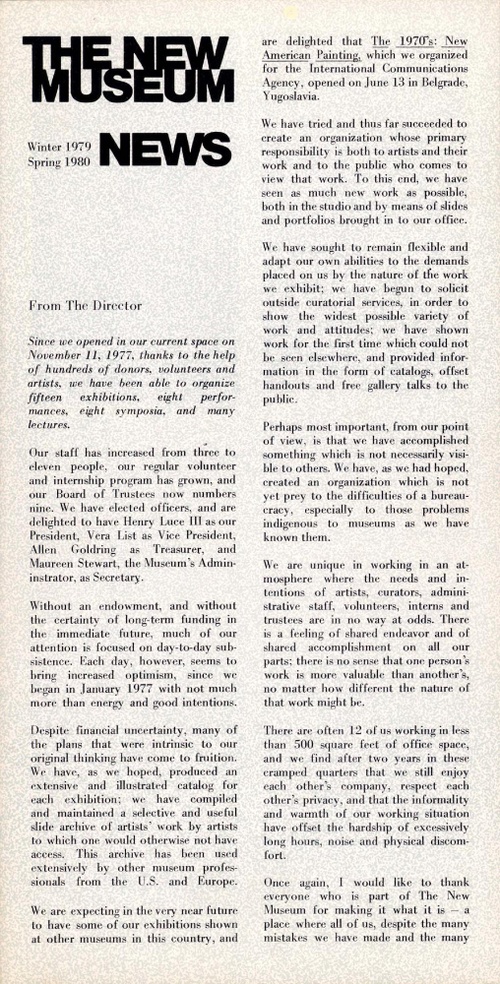
-
The education program at the New Museum was started by Ed Jones in 1980, with events including lectures, symposia, a unique program for elementary school children, and programs geared toward college students and adults. Report 1979–1981 (New York: New Museum, 1981), 3.
, 1981The New Museum of Contemporary Art: Report, 1979 - 1981
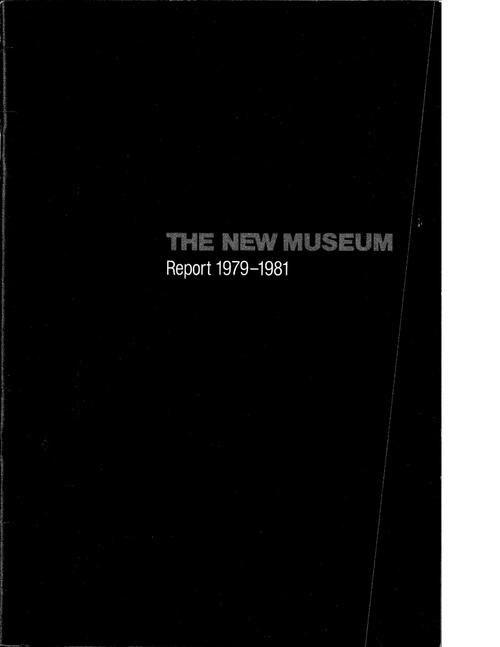
-
Allan Schwartzman, untitled essay, in Temporarily Possessed: The Semi-Permanent Collection, ed. Brian Goldfarb, et al. (New York: New Museum, 1995), 45.
, 1995Temporarily Possessed: The Semi-Permanent Collection
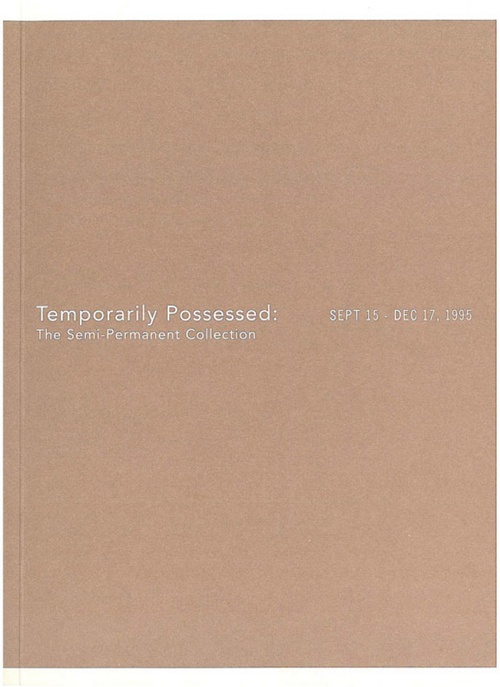
-
The New Museum’s second exhibition series, Outside New York, challenged the notion that serious art was not being made outside acknowledged major art centers by showcasing the variety and vitality of art being made across the United States to a New York audience. The series paralleled the Museum’s first exhibition series, New Work / New York, by presenting artists who had little prior exposure or scholarly appraisal—sometimes even in their own communities—and whose practices, likewise, existed outside the mainstream. Outside New York exhibitions were typically these artists’ first presentations in New York. The series ran from 1978 to 1984, culminating in “New Work: New York / Outside New York,” a major exhibition presenting an integrated picture of new work and new ideas from across the United States.
, 1978 – 1984Outside New York

-
Lorraine O’Grady’s guerrilla performance of Mlle Bourgeoise Noire (1980–83) during the 1981 opening of “Persona” at the New Museum is described by the artist as “in part, a critique of the racial apartheid still prevailing in the mainstream art world.” Documentary photographs are viewable on the artist’s website: http://lorraineogrady.com/art/mlle-bourgeoise-noire/.
-
Both “Paradise Lost/Paradise Regained: American Visions of the New Decade” and “The End of the World: Contemporary Visions of the Apocalypse” explored themes of dystopia and the apocalyptic.
, 1984“Paradise Lost / Paradise Regained: American Visions of the New Decade”
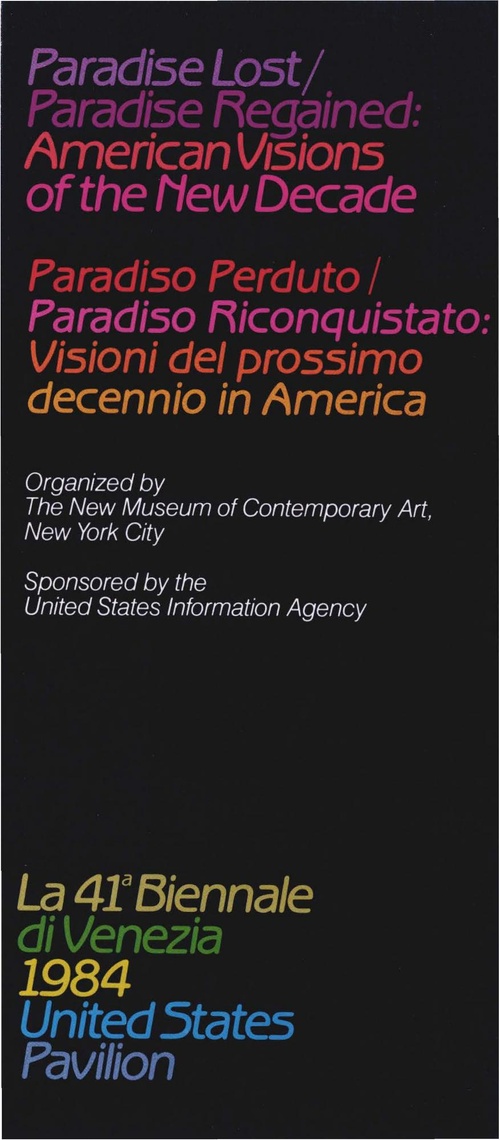
-
William Olander passed away of AIDS-related illness in 1989. The same year, the New Museum established the William Olander Memorial Fund for the promotion of the fields of photography, video art, performance, and cultural activism in his honor. Twelfth Anniversary Report (New York: New Museum, 1989), 7.
, 1987The New Museum of Contemporary Art: Tenth Anniversary, 1977-1987
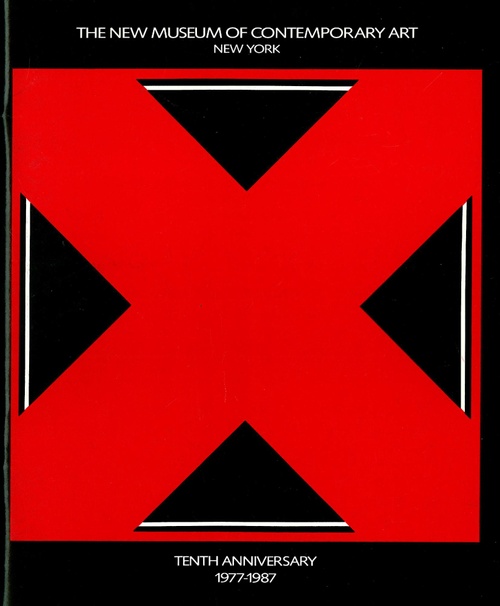
-
Olander was Curator of Modern Art and then Acting Director at the Allen Memorial Art Museum at Oberlin College from 1979 to 1985. News/Calendar (New York: New Museum, 1985), 2.
, 1985New Museum, News / Calendar (Spring and Summer, 1985)

-
The Documentary Sources in Contemporary Art anthology series, which documented significant thought, writing, and criticism on contemporary art, was initiated and sustained by successive grants from the Luce Fund for Scholarship in American Art. Henry “Hank” Luce III also helped secure the New Museum’s first permanent home in the Astor Building on Broadway, where it was located from 1983 to 2004. New Museum of Contemporary Art, Report 1981 – 1984 (New York: New Museum of Contemporary Art, 1984), 1-6.
, 1984The New Museum of Contemporary Art: Report, 1981-1984
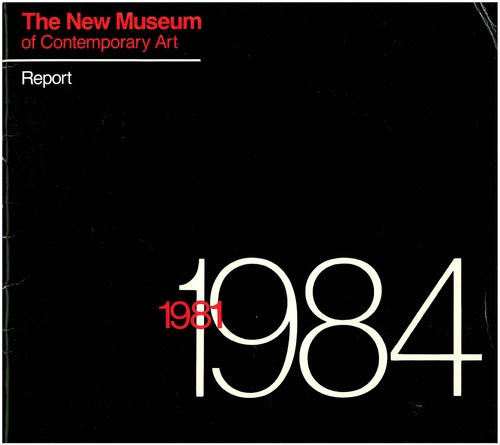
-
In 1986, the New Museum began a series of in-house discussions with its Artist Advisory Board, inspired by the desire to expand the Museum’s exhibitions beyond traditional formats. As a result, a call was put out for experimental and provocative artist proposals, culminating in the Artists Projects exhibition series in 1988. Artists Projects, exhibition brochure (New York: New Museum, 1988).
, 1988Brochure: Artists Projects
